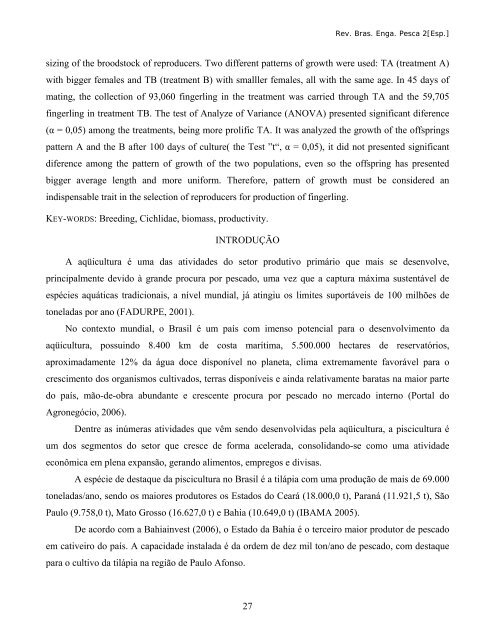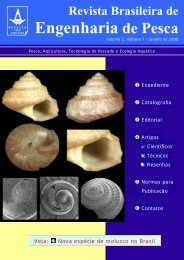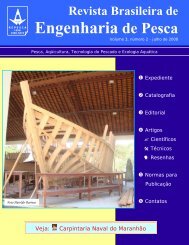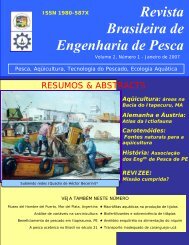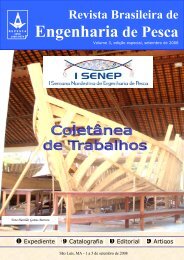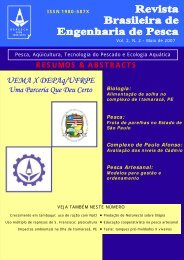Edição Especial - Engenharia de Pesca - Uema
Edição Especial - Engenharia de Pesca - Uema
Edição Especial - Engenharia de Pesca - Uema
Create successful ePaper yourself
Turn your PDF publications into a flip-book with our unique Google optimized e-Paper software.
Rev. Bras. Enga. <strong>Pesca</strong> 2[Esp.]sizing of the broodstock of reproducers. Two different patterns of growth were used: TA (treatment A)with bigger females and TB (treatment B) with smalller females, all with the same age. In 45 days ofmating, the collection of 93,060 fingerling in the treatment was carried through TA and the 59,705fingerling in treatment TB. The test of Analyze of Variance (ANOVA) presented significant diference(α = 0,05) among the treatments, being more prolific TA. It was analyzed the growth of the offspringspattern A and the B after 100 days of culture( the Test ”t“, α = 0,05), it did not presented significantdiference among the pattern of growth of the two populations, even so the offspring has presentedbigger average length and more uniform. Therefore, pattern of growth must be consi<strong>de</strong>red anindispensable trait in the selection of reproducers for production of fingerling.KEY-WORDS: Breeding, Cichlidae, biomass, productivity.INTRODUÇÃOA aqüicultura é uma das ativida<strong>de</strong>s do setor produtivo primário que mais se <strong>de</strong>senvolve,principalmente <strong>de</strong>vido à gran<strong>de</strong> procura por pescado, uma vez que a captura máxima sustentável <strong>de</strong>espécies aquáticas tradicionais, a nível mundial, já atingiu os limites suportáveis <strong>de</strong> 100 milhões <strong>de</strong>toneladas por ano (FADURPE, 2001).No contexto mundial, o Brasil é um país com imenso potencial para o <strong>de</strong>senvolvimento daaqüicultura, possuindo 8.400 km <strong>de</strong> costa marítima, 5.500.000 hectares <strong>de</strong> reservatórios,aproximadamente 12% da água doce disponível no planeta, clima extremamente favorável para ocrescimento dos organismos cultivados, terras disponíveis e ainda relativamente baratas na maior partedo país, mão-<strong>de</strong>-obra abundante e crescente procura por pescado no mercado interno (Portal doAgronegócio, 2006).Dentre as inúmeras ativida<strong>de</strong>s que vêm sendo <strong>de</strong>senvolvidas pela aqüicultura, a piscicultura éum dos segmentos do setor que cresce <strong>de</strong> forma acelerada, consolidando-se como uma ativida<strong>de</strong>econômica em plena expansão, gerando alimentos, empregos e divisas.A espécie <strong>de</strong> <strong>de</strong>staque da piscicultura no Brasil é a tilápia com uma produção <strong>de</strong> mais <strong>de</strong> 69.000toneladas/ano, sendo os maiores produtores os Estados do Ceará (18.000,0 t), Paraná (11.921,5 t), SãoPaulo (9.758,0 t), Mato Grosso (16.627,0 t) e Bahia (10.649,0 t) (IBAMA 2005).De acordo com a Bahiainvest (2006), o Estado da Bahia é o terceiro maior produtor <strong>de</strong> pescadoem cativeiro do país. A capacida<strong>de</strong> instalada é da or<strong>de</strong>m <strong>de</strong> <strong>de</strong>z mil ton/ano <strong>de</strong> pescado, com <strong>de</strong>staquepara o cultivo da tilápia na região <strong>de</strong> Paulo Afonso.27


